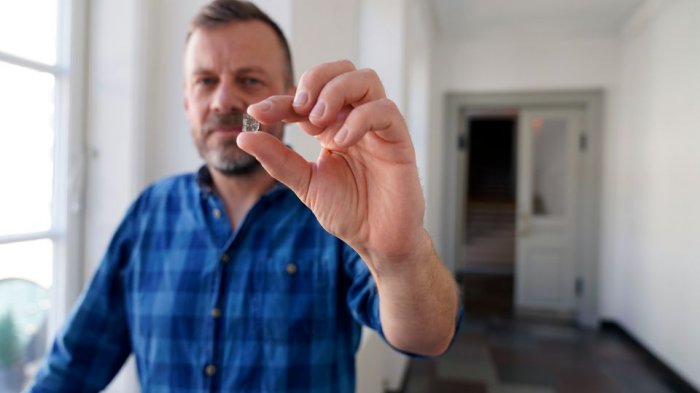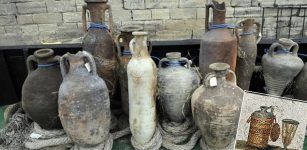Evidence Vikings Had Windows With Glass Panes Already Between 800 And 1100
Jan Bartek - AncientPages.com - Vikings are often depicted as crude barbarians running around yelling and waving with swords, but there are many reasons we should reconsider whether this is an accurate picture.
We have heard it all before. The image of a brutal Viking king sitting on his throne in a gloomy room, surrounded only by the glow of glimmering torches. Instead, it could be that the Viking kings sat in rooms partly illuminated by the inflow of light through window glass – possibly in the same way as glassed panes that features in churches.
Viking village. Credit: Adobe Stock - Claudia Nass
New research shows that the Vikings already had windows with glass panes between 800 and 1100.
“Several fragments of glass windows found on important Viking Age sites in South Scandinavia made us wonder if it was just a mere coincidence that they were there. And it wasn’t, they can be dated to the Vikings Age and most likely must have been in use in that time-period as well”, says conservator Torben Sode, who first noticed the special find material.
What makes the discovery so startling is the fact that glass windowpanes were not prevalent in Denmark until several centuries later when medieval churches and castles were constructed. Once again, this new knowledge spotlights the fact that the Vikings were far more advanced than they are often depicted.
“This is yet another shift away from the image of unsophisticated barbaric Vikings swinging their swords around. In fact, we are talking about a cultivated Viking elite with royal power that equalled that, for example, of Charlemagne, king of the Franks. This is something that is often omitted in the simplistic Hollywood portraits of Vikings,” says the National Museum’s senior researcher Mads Dengsø Jessen.
Viking Age Glass
The research is based on analyses of 61 fragments of glass panes, which were found over the past 25 years in six different excavations – five in southern Scandinavia and one in Hedeby in Schleswig – of the farms of Viking noblemen, pre-Christian temples and early urban environments.
In other words, we have known about the glass for several years, but no one analyzed it until now. This is because we only associated early window glass with the Middle Ages, therefore assuming that the glass could not originate from the Viking Age but must have been the result of ‘pollution’ from later periods.
Now, however, chemical isotope analyses of the glass panes shows that the glass was made of Near Eastern soda glass or Northern European potash glass, which can be dated from well before the 12th century – in other words, long before the churches and castles of the Middle Ages.
Pillaged Or Purchased?
Nothing indicates that the Vikings could produce glass for windows, but there is no doubt that they were familiar with the material from Europe, where glazed windows had long been a feature of churches and imperial halls: for example in Anglo-Saxon and Carolingian culture, where we have discovered exactly the same type of glass that has now been found from the Viking Age in southern Scandinavia.
This is hardly a coincidence, since the Vikings looked south for inspiration. Mads Dengsø Jessen explains:
“We know that well-known Vikings, such as Harald Klak, visited the south, where the Vikings had a political network and close trade links. So, of course, they were familiar with glass panes from the buildings of society’s upper echelons there. It is thus also very likely that the Vikings also had glazed windows – a fact now confirmed by recent research.”
Mads Dengsø Jessen, Senior Researcher at the National Museum of Denmark, with a piece of Window Glass fragment from the Viking Age. Photo: John Fhær Engedal Nissen, the National Museum of Denmark.
There is also a suspicion that the Vikings may have expropriated the window glass from monasteries and churches during raids. However, according to the researchers, this is less likely, given that the glass was found at several different Viking sites, while the chemical signature proves that the glass panes originate from different parts of Europe and the Near East.
In other words, it is most likely that the Vikings acquired it through trade.
Glass Windows In The Halls Of Viking Noblemen
When it comes to the Vikings, glass windows were reserved for the upper echelons of society and for religious use, as was the case in the rest of Europe. Therefore, according to Mads Dengsø Jessen, there may have been glass windows in the iconic hall buildings of the Vikings.
They were not the large, transparent windows we have today, but probably smaller windows, possibly composed of flat pane glass in different shades of green and brown. As Mads Dengsø Jessen points out, the idea was not to be able to look out, but to create a colorful inflow of light into the building.
See also: More Archaeology News
“It is also reasonable to assume that they regarded the presence of glass windows as something special and magical that could let sunlight in and illuminate the room, while keeping out cold, wind and rain”, underlines Torben Sode in a press statement.
The result has been published in the academic Danish Journal of Archaeology, and the research was conducted by Torben Sode (conservator and glass specialist), Bernard Gratuze (research director, University of Orléans, France) and Mads Dengsø Jessen (the National Museum of Denmark).
Written by Jan Bartek - AncientPages.com Staff Writer






















